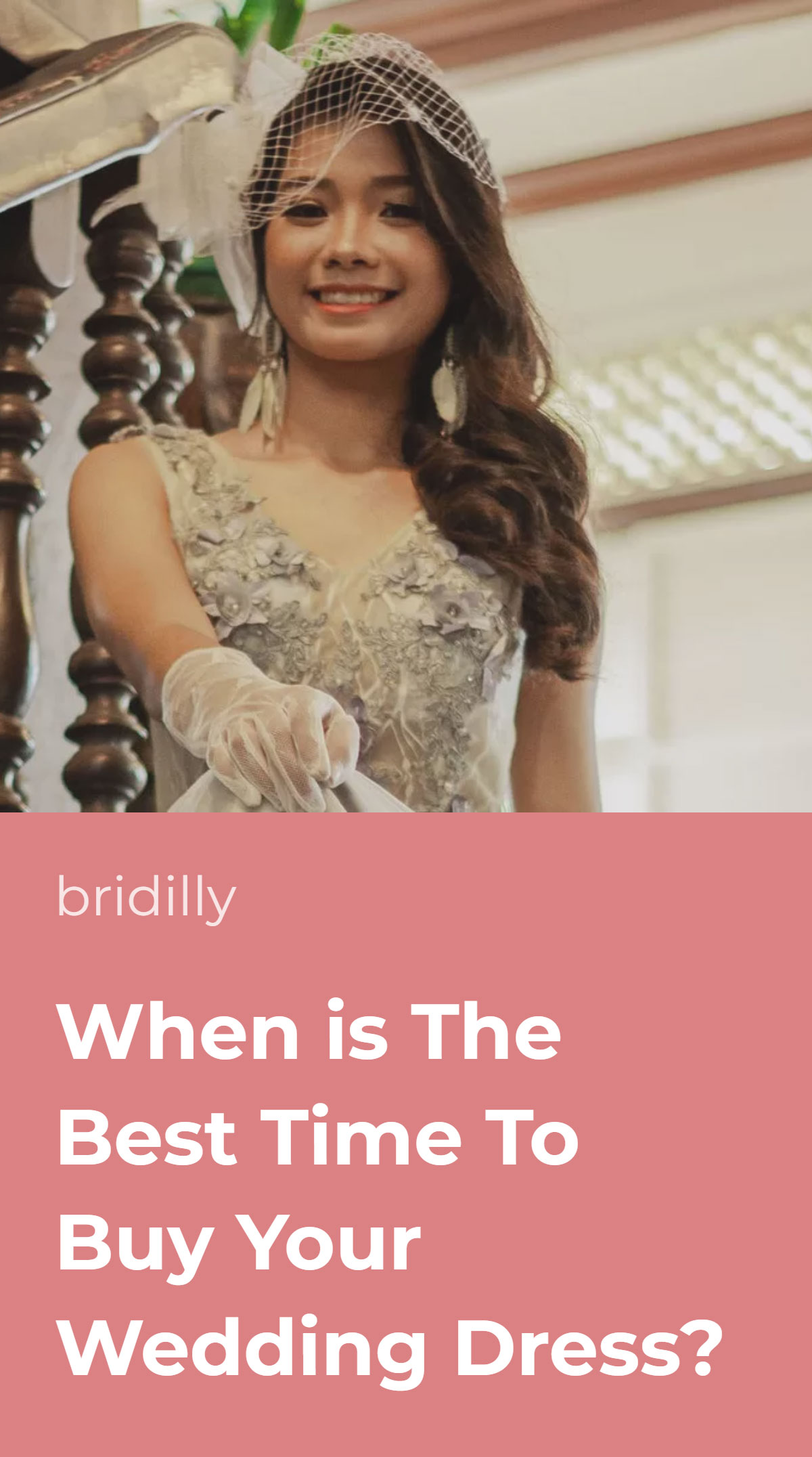One of the first thoughts that crosses the minds of all engaged women is – when to buy a wedding dress?
Your wedding may seem ages away, but the preparations should start early – perhaps, even earlier than you think.
Don’t expect to find that dream gown from your first try, and don’t expect it to fit flawlessly right away. That’s a one-in-a-thousand instance.
You will likely need some time to research local bridal salons and wedding dress styles, then try dozens of gowns to find the perfect one and allow enough time for alterations.
Plus, like all stores, bridal salons have periods of sales and new arrivals. The demand can also affect prices, so if your budget is limited, that’s a point to consider.
Table of Contents [show]
Allow Enough Time For Alterations
Don’t leave your wedding dress shopping for the last moment, as most ready-made gowns will require alterations to fit you perfectly.
Even if the dress size is correct, each body is different, and you’ll want it to be tailored to every nuance of your figure.
You may neglect a poor fit of a casual skirt, but every bride wants to look flawless on her wedding day.
Furthermore, many women lose weight before their wedding – intentionally or from all the stress involved in wedding planning.
The wedding dress alteration timeline depends on the labor complexity. Generally, tailors advise brides to bring their dresses in for the first fitting about three months before the event.
During the fitting, the seamstress will inspect every aspect of the dress to evaluate what type of alterations it needs and how much time it will take.
Even a seemingly minor change that takes a couple of days, such as taking in the waist, can affect the overall dress fit. That’s why you need to allow at least three months for any alterations.
Some dresses don’t require major alterations but only basic adjustments such as shortening the hemline or sleeves. Still, you won’t know how significant adjustments your dress requires until you try it on.
Bespoke customizations require even more time, at least four months.
Therefore, start shopping for your dress no later than five months before the event. This will ensure that you’ll have enough time to bring any ideas to life when you find your perfect gown.
Note that five months is an estimation for offline wedding dress shopping. If you plan to buy your gown online, order it even earlier, over a half year in advance, to ensure it arrives on time.
Don’t rely on the earliest delivery times stated on the website – you should hope for the best but be prepared for the worst. Inconveniences happen, and the delivery can delay significantly.
When Do New Collections Arrive?
Late winter and late summer are arguably the best times to shop for a wedding dress. That’s the time when new collections arrive in bridal salons, so you’ll get a broader dress selection.
Buying a dress early only to find a better one from a newer collection is upsetting. If you’re concerned about trends or want to try on as many options as possible, wait for new arrivals.
Most designers release a spring-summer collection in January and a fall-winter collection in June or July.
It usually takes two to three months for the stores to get new collections, so expect to shop for your dress in March or September.
Of course, even when waiting for the new collection, you shouldn’t forget about the alteration timeline. Remember that you should buy the dress no later than three months before the wedding, that’s the golden rule.
So, if your wedding is in May, shopping for a dress in March may be a bit too late. Instead, look for a gown from the fall-winter collection that arrives in stores in September.
Note that the exact times of new collection arrival may differ depending on the dress designer and salon.
If you’re interested in a particular brand, do your research to find out when they release new styles and when they arrive in local stores.
Sample Sale Season
When new collections arrive, stores need to free some space and strive to sell out old collections as quickly as possible.
This time is known as the wedding dress sample sale season, when you can get a gown with a 40-90% markdown.
For this reason, March and September are the best times for wedding dress shopping, both for brides who wish to get the trendiest gown and for those who are limited in budget.
Waiting for the sample sale season is one of the best ways to save money on a wedding dress, but keep in mind that your selection can be limited.
The best styles tend to sell out quickly, and your desired dresses may not be available in your size.
Most sample wedding dresses are size 8, so this option is only suitable for brides sized 6-10 who don’t mind some alterations.
Another point is that sample dresses are typically final sales, so returns are impossible.
You should be 100% sure it’s your perfect dress to avoid regretting your decision later. And since sample dresses hang on display for months, you should carefully inspect the gowns for damages.
Wait Until You Pick The Venue
One of the points often neglected when choosing a bridal gown is the wedding venue. The dress should be appropriate for the location and fit into the interior style.
However, freshly engaged brides often head to the local bridal salon right away, forgetting everything else. I can’t blame them – trying on exquisite wedding gowns is the dream of many women.
Meanwhile, an elaborate ball gown with a dramatic train looks odd on a beach, and a flowy rustic dress gives off an entirely different vibe than a castle. Therefore, wait until you pick your venue.
You can start researching wedding dress styles to understand what you like and which silhouettes best fit your figure. But leave the purchase for when you are sure about the location.
Of course, you want to allow enough time for alterations, so you shouldn’t postpone the purchase either. Thankfully, the venue is among the first things most couples decide on, so you will likely have enough time.
Six months before the wedding, most couples have the core aspects of the wedding planned, and the bride can finally focus on the dress.
But if you’re struggling to find the right venue on time, consider choosing a dress in a neutral style.
At the very least, ensure you’re on the same page with your S.O. about your desired venue location and style.
You may want to get married in a forest and buy a romantic bohemian gown, but what if he wants a biker-themed wedding?
What If You’re Losing Weight?
Getting engaged is exciting, but if you’re losing weight, the question “when to shop for a wedding dress?” can cause anxiety. However, this seemingly tricky issue has a relatively straightforward solution.
If you’ve got under 25 pounds to go, get a dress of your current size about four months before the event – just like you would do if you weren’t losing weight.
Generally, 25 pounds equal one clothing size, so the alterations shouldn’t be drastic.
If you’re losing over 25 pounds, don’t rush with the shopping. Wait until you’re close to your desired weight and get a dress then – but not later than several months before the event.
In other words, even if you’re losing weight, you should observe the golden rule of the wedding dress fitting timeline.
Health experts don’t recommend losing over two pounds weekly, so you shouldn’t lose over 25 pounds in a few months anyway.
A common mistake of brides shopping for a dress while losing weight is ordering a smaller size.
Usually, this only leads to increased stress and more significant alterations. You don’t have to put your health at risk for the sake of reaching your goal.
Increased Demand Seasons
If you’re wondering what’s the best time to shop for a wedding dress, you may as well want to know what’s the worst time to shop for a wedding dress.
Thanksgiving commences the primary engagement season in the U.S. that ends after New Year.
Summer is traditionally the most popular time for weddings, though more and more couples today prefer spring and fall.
January is the crunch time to shop for a wedding dress for spring brides, and for summer and fall brides, it’s a perfect time.
Furthermore, wedding dress shopping is a great way to beat the winter blues. Either way, bridal salons see an influx of freshly engaged women at the start of the year, and increased demand often means higher prices.
Of course, not all bridal salons change their prices depending on the season unless it’s sample sale time.
Still, you can forget about a peaceful individual appointment if you plan to shop in January at a popular chain store.



















No Comments Add one
Leave a Comment